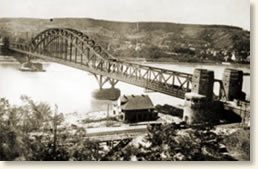|
Capturing the Bridge
at Remagen, 1945
Crossing the Rhine River
Winding its way from Switzerland to the North
Sea, the Rhine River has historically stood as a natural barrier defending the
German heartland that lies beyond it. Since the days of the Roman Empire, the
river's cold, wide
and swift waters have proven to be a formidable obstacle to any aggressor
intending to cross it. These facts were well known to the Allied commanders as
their forces continued their assault toward the German interior in March 1945.
The crossing of the Rhine would be a difficult and costly task.
 |
The bridge across the Rhine at Remagen
|
As the Allied armies approached, Hitler ordered the destruction of all the
bridges that spanned the Rhine. By March 7, they all had been, except one - the Ludendorff railroad
bridge at the little resort town of Remagen a few miles to the southeast of Cologne.
On that day Lady Luck smiled on the Allies. At about 1 PM an American reconnaissance
patrol reached the wooded hills overlooking the river at Remagen, and to their
surprise, discovered the bridge still intact. Then the race began.
The Americans quickly launched a full-scale assault on the bridge while the defending
Germans scrambled to detonate the explosive charges that had been set to destroy
it. The fighting was fierce as both sides realized what was at stake. The American
soldiers scrambled under withering gun fire from girder to girder returning
fire and ripping the explosives from the bridge's super structure. The German's
were successful in detonating some explosives - but not enough to destroy the
bridge. By 4 PM - approximately four minutes after the assault began - the
Americans had reached the other side of the river and secured the bridge. When
informed, 1st Army commander Omar Bradley responded: "Hot dog . . .this
will bust 'em wide open. Shove everything you can across!"
Everett Holles was a NBC Radio war correspondent accompanying the troops that made the assault over the Rhine. He describes what happened as the American force approached the bridge:
"On beyond the four towers of the Apollinariskirche
that glistened in a light drizzle of rain they saw Remagen’s 400-yard-long,
three-span bridge across the Rhine. The bridge ran to the village of Erpel
on the east bank and across it lay two railroad tracks. Other American forces
had come up against the same sort of thing before, but always, as they came
to the Rhine crossings, the bridges went up in great explosions before their
eyes, set off by German demolition engineers.
Traffic was still moving across the Ludendorf Bridge.
On the other side locomotives puffed, awaiting orders to pull out. Lt. Col.
Leonard Engemann of Minneapolis, in command of a reconnaissance party, was
determined to save this bridge if it was at all possible. So, at 3:50 o’clock,
a platoon led by Lieut. Emmett Burrows of New York City, sped down the slope
to the bridge entrance. There was a flurry of shooting as the Germans, taken
completely by surprise, scurried about trying to organize a defense. A German
gun was knocked out, some German soldiers killed. Then the Yanks, crouching
low against machine gun fire coming from the bridge towers, ran out onto
the bridge. Just as they stepped on the span, an explosion occurred three-quarters
of the way down the bridge. The Germans were setting off demolition charges,
and the men thought surely their chance was gone. But no, only slight damage
was done. They raced on.
Sgt. Alexander A. Drabik, a tall, lanky former butcher from Holland, Ohio,
was the first American across the Rhine, the first invader to reach its east
bank since the time of Napoleon. But he wanted all the honors passed on to
a young lieutenant of the engineers, John W. Mitchell of Pittsburgh.
‘While we were running across the bridge – and, man, it may have
been only 250 yards but it seemed like 250 miles to us – I spotted this
lieutenant, standing out there completely exposed to the machine gun fire that
was pretty heavy by this time.’
 |
Sgt. Alexander A. Drabik
1st across the bridge
|
‘He was cutting wires and kicking the German demolition
charges off the bridge with his feet! Boy that took plenty of guts. He's the
one who saved the bridge and made the whole thing possible – the kinda
guy I'd like to know.’
Soon the bridge was swarming with Americans, while Mitchell, joined now by
other engineers, cut and jerked out wires leading to dynamite charges. Gingerly
they detached detonators and lifted boxes of explosives from the piers.
Later, from prisoners, the Americans learned that
the Germans planned to blow up the span at precisely four o’clock.
But the German officer assigned the demolition job was drunk when the American
tanks reached Remagen. This officer, a lieutenant, had gone into the town
of Eprel as the Yanks approached and spread the word boastfully that ‘the
bridge goes up at four o’clock
this afternoon.
German soldiers and civilians, gathering from miles
around, were sitting in ‘grandstand’ seats
at every vantage point on the east bank, waiting for the spectacular event
to come off, when Burrows’ patrol ran onto the bridge – ten minutes
before the hour fixed for its destruction. The German lieutenant signaled the
plunger down. Two small explosions occurred, but the bridge only shuddered
and remained standing. Several of the fuses had been faulty.
. . .By nightfall scores of tanks, trucks by the hundreds were moving up and
across the Rhine. All roads leading to Remagen were packed with American troops
and trucks and armor and guns. Soldiers who had been ready to drop from fatigue
stepped on the accelerator, broad grins splitting their begrimed faces. The
Ludendorf bridge had become a one-way street, east-bound."
References:
This eye-witness account appears in Holles, Everett, Unconditional Surrender (1945); Hechler, Karl, The Bridge at Remagen (1957); Turner, Barry, Countdown to Victory (2004).
How To Cite This Article:
"Capturing the Bridge at Remagen, 1945," EyeWitness to History, www.eyewitnesstohistory.com (2008).
|






